NOTICE: This web page has been archived for historical purposes. Its content is no longer maintained, so information may be out of date and links may not work properly. For current Healthy Water features, please see the Newsroom, Features, & Observances page.
World Water Day 2010
Water Quality, Ecosystems, and Human Well-Being
Water is considered to be the most important resource for sustaining ecosystems, which provide life-supporting services for people, animals, and plants (1). Because contaminated water is a major cause of illness and death, water quality is a determining factor in human poverty, education, and economic opportunities (2).
Unfortunately, worldwide water quality is declining, threatening the health of ecosystems and humans worldwide (2). Various factors influence this deterioration, including population growth, rapid urbanization, land use, industrial discharge of chemicals, and factors resulting from climate change.
Today, hundreds of millions of people do not have access to improved sources of drinking water (3), leaving them at risk for water-, sanitation-, and hygiene- (WASH) related diseases. Worldwide, 1.5 million children die annually from diarrheal illnesses that are caused by unsafe water, poor sanitation, and inadequate hygiene (3). Devastating epidemics of cholera, such as the 2008-2009 outbreak in Zimbabwe [PDF 2 pages] that caused more than 98,000 cases of illness and 4,200 deaths, are only the "tip of the iceberg," as most waterborne diseases, illnesses, and deaths are never reported (4).
Responding to these challenges requires a spectrum of interventions. The prevention or minimization of water pollution is critical to improving drinking water quality. Interventions to improve drinking water quality range from disinfecting water at the household level (point-of-use [POU] treatment) to water management at the community level (Water Safety Plans [WSPs]). In some situations, more than one type of intervention is needed. For example, both POU treatment and WSPs may be needed for piped water systems with intermittent service. When this happens, the different interventions are complementary, not competitive.
CDC's Global Water, Sanitation, and Hygiene (WASH) Program
Inadequate water, sanitation, and hygiene (WASH) conditions exist in a range of settings, from temporary refugee camps to permanent housing in large cities. CDC is engaged in global WASH activities that respond to needs across that spectrum and help prevent global water-, sanitation-, and hygiene-related disease. CDC's Global WASH Program has several areas of activity:
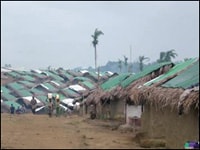
A refugee camp housing internally displaced persons, Liberia. Photo Credit: Thomas Handzel
1.CDC's International Emergency and Refugee Health Activity
Worldwide, there are approximately 25 million refugees, internally displaced, or emergency-affected persons. Refugees and displaced persons often live in crowded conditions where access to safe drinking water and sanitary services is extremely poor. Water- and hygiene-related diseases, including cholera and dysentery, are some of the primary causes of illness and death in such settings, especially among young children.
CDC's International Emergency and Refugee Health Activity:
- Works with U.S. Government agencies, United Nations (UN) agencies, and non-governmental organizations (NGOs) to reduce death and disability in emergency-affected populations
- Provides technical assistance to the U.S. Office of Foreign Disaster Assistance in responding to acute emergencies
- Assists the Office of the United Nations High Commissioner for Refugees (UNHCR) in monitoring and evaluating water, sanitation, and hygiene programs in refugee camps
- Assists the United Nations Children's Fund (UNICEF) in evaluating water, sanitation, and hygiene interventions.
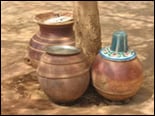
Household water storage -- changing ways water is stored and protected in homes. Photo credit: D. Lantagne.
2. CDC's Point-of-Use Water Treatment Activity: The Safe Water System
In areas where access to safe water, appropriate wastewater management, and adequate sewage systems are not feasible, CDC's Safe Water System (SWS) empowers people to improve and protect the quality of their drinking water. The SWS allows individuals to treat and store water in their homes using simple and inexpensive technologies. It consists of four steps:
- Point-of-use treatment of contaminated water
- Safe water storage
- Improved hygiene
- Behavior change techniques
3. CDC's Community Hygiene Activity
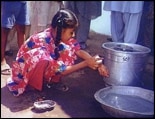
Photo Credit: Steve Luby
When people in resource-poor settings wash their hands with soap, they can reduce their risk of diarrheal and respiratory disease by approximately 50% (5,6). CDC's Community Hygiene Activity works to understand and promote effective, accessible, and inexpensive hygiene measures needed to prevent diseases that claim millions of lives each year.
To accomplish this goal, the Community Hygiene Activity focuses on three areas:
- Health impacts of handwashing with soap
- Tools for measuring handwashing behavior
- Models of handwashing behavior change
In an effort to establish impactful and cost-effective methods for behavior change, CDC's Community Hygiene Activity is exploring the influence of schools, campaigns (such as Global Handwashing Day), and public-private partnerships on handwashing behavior.
4. CDC's WASH Away Neglected Tropical Diseases (NTDs) Activity
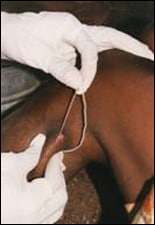
Guinea worm extraction from a leg. Photo Credit: The Carter Center.
CDC's WASH Away Neglected Tropical Diseases (NTDs) Activity focuses on the impacts that improved water, sanitation, and hygiene (WASH) has on various diseases, including NTDs such as Guinea worm disease (GWD). This activity:
- Evaluates WASH effectiveness in reducing disease;
- Integrates WASH interventions within existing programs treating NTDs and diarrheal disease
- Assesses the enabling factors and barriers to WASH delivery and sustainability.
CDC has been a partner in the global Guinea Worm Eradication Program (GWEP) since it began in 1986. Using simple interventions to provide safe drinking water, the GWEP has reduced GWD occurrence from 3.5 million cases in 20 countries in 1986 to fewer than 4,000 cases in 4 countries in 2009 (7).
5. CDC's Environmental Global WASH Activity
In areas where community water systems, sanitation construction, and hygiene education are existing or feasible, CDC's Environmental Global WASH Activity works with public health partners to measure and improve the impact and sustainability of these important interventions.
The Environmental Global WASH Activity:
- Evaluates the sustainability of WASH interventions over the long term (5 – 10 years);
- Improves drinking water quality through the implementation of Water Safety Plans (WSPs) in water systems; and
- Researches the public health impacts of sanitation programs.
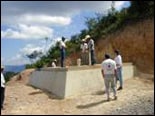
Water storage tank for small community water system in Guatemala. Photo Credit: Richard Gelting.
This activity investigates the factors that contribute to the sustainability of WASH interventions—as well as barriers to sustainability—by research and assessment of current interventions. The team also promotes, participates in, and evaluates Water Safety Plans in lower income countries to ensure drinking-water quality.
CDC in Haiti
In addition to these WASH activities, CDC has been working in Haiti to improve access to safe water and sanitation and reduce the risk of water-, sanitation-, and hygiene-related diseases among those affected by the Jan 12, 2010 earthquake. For information, visit CDC Responds to the Haiti Earthquake.
More Information
- World Water Day
- United Nations Environment Programme (UNEP)
- CDC's Healthy Water Website
- CDC's Global Water, Sanitation, and Hygiene Website
References
- The United Nations Environmental Programme (2009), Report: Water security and ecosystem services: The critical connection. UNEP, Nairobi, Kenya. ISBN: 92-807-3018-0. [PDF - 56 pages]
- World Water Assessment Programme (2009), The United Nations World Water Development Report 3: Water in a Changing World. UNESCO: Paris and Earthscan: London.
- World Health Organization and United Nations Children's Fund Joint Monitoring Programme for Water Supply and Sanitation (2008), Progress on Drinking Water and Sanitation: Special Focus on Sanitation. UNICEF: New York and WHO: Geneva. ISBN: 92-806-4313-8.
- Mintz ED, Guerrant RL. A Lion in Our Village – The Unconscionable Tragedy of Cholera in Africa. N Engl J Med 2009;360:1060-1063.
- Luby SP, et al. Effect of intensive handwashing promotion on childhood diarrhea in high-risk communities in Pakistan: A randomized controlled trial. JAMA 2005;291(21):2547-54.
- Luby SP, et al . Effect of handwashing on child health: A randomised controlled trial. Lancet 2005;366(9481):225-33.
- WHO Collaborative Center for Research, Training, and Eradication of Dracunculiasis. Guinea worm wrap-up #194. Updated January, 2010.
Get email updates
To receive email updates about this page, enter your email address:
Contact Us:
- Centers for Disease Control and Prevention
1600 Clifton Rd
Atlanta, GA 30333 - 800-CDC-INFO
(800-232-4636)
TTY: (888) 232-6348 - Contact CDC–INFO
 ShareCompartir
ShareCompartir
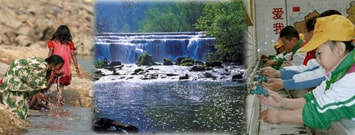 Each year, on March 22, World Water Day attracts international attention to the conservation and development of water resources. World Water Day 2010 focuses on water quality in conjunction with its theme "Clean Water for a Healthy World." Learn more about water quality challenges, the importance of water quality in sustaining healthy ecosystems and people, and what CDC is doing to address water issues around the world.
Each year, on March 22, World Water Day attracts international attention to the conservation and development of water resources. World Water Day 2010 focuses on water quality in conjunction with its theme "Clean Water for a Healthy World." Learn more about water quality challenges, the importance of water quality in sustaining healthy ecosystems and people, and what CDC is doing to address water issues around the world.

